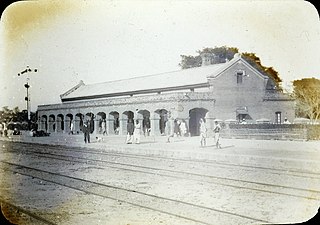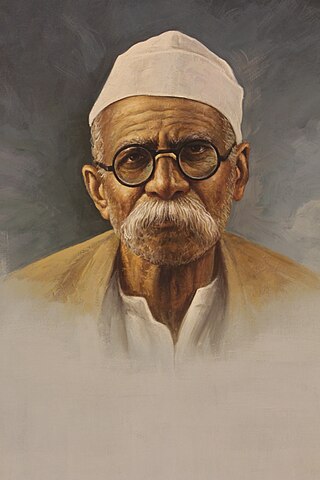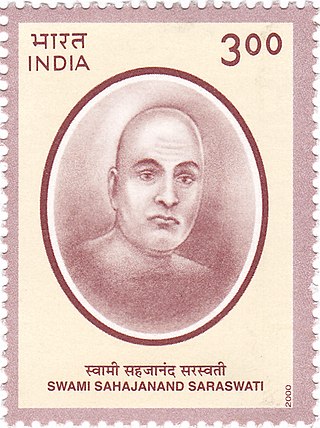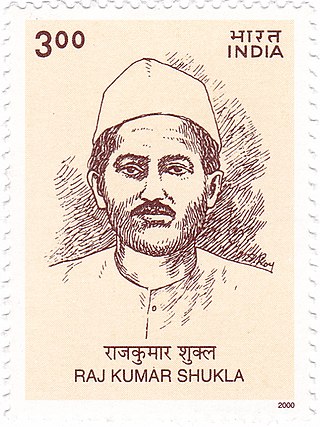
Mohandas Karamchand Gandhi was an Indian lawyer, anti-colonial nationalist and political ethicist who employed nonviolent resistance to lead the successful campaign for India's independence from British rule. He inspired movements for civil rights and freedom across the world. The honorific Mahātmā, first applied to him in South Africa in 1914, is now used throughout the world.

Kasturba Mohandas Gandhi was an Indian political activist who was involved in the Indian independence movement during British India. She was married to [[Mohandas

The Anarchical and Revolutionary Crimes Act of 1919, popularly known as the Rowlatt Act, was a law, applied during the British India period. It was a legislative council act passed by the Imperial Legislative Council in Delhi on 18 March 1919, indefinitely extending the emergency measures of preventive indefinite detention, imprisonment without trial and judicial review enacted in the Defence of India Act 1915 during the First World War. It was enacted in the light of a perceived threat from revolutionary nationalists of re-engaging in similar conspiracies as had occurred during the war which the Government felt the lapse of the Defence of India Act would enable.

East Champaran is an administrative district in the state of Bihar in India.The district headquarters are located at Motihari. Prior to 1971, there was a single district called "Champaran". On 1 December 1971, the district was divided into 2 parts East Champaran and West Champaran. In early days the land of East Chamapran was ruled by different kingdoms as Videha, Sunga, Kanvas. It is also believed that Champaran used to be a major part of King Janak's empire. Mahatma Gandhi started his famous Satyagraha movement from here.

Motihari is a city and headquarters of East Champaran district in the Indian state of Bihar. It is located 80 kilometres west of Muzaffarpur and 152 kilometres northwest of the state capital Patna. In early days the land of Motihari was ruled by different kingdoms as Videha, Sunga, Kanvas. It is also believed that Champaran used to be a major part of King Janak's empire. Mahatma Gandhi Started his famous Satyagraha movement from here.

All India Kisan Sabha, is the peasant or farmers' wing of the Communist Party of India, an important peasant movement formed by Sahajanand Saraswati in 1936.
Champaran is a region of Bihar in India. It is now divided into an East Champaran district and a West Champaran district.

Pandurang Mahadev Bapat, popularly known as Senapati Bapat, was a figure in the Indian independence movement. He acquired the title of Senapati, meaning commander, as a consequence of his leadership during the Mulshi Satyagraha. In 1977, the Indian government issued a postage stamp to commemorate him.

Gandhi Maidan is a historic ground in Patna, near the banks of the Ganges River, in Bihar, India. The Golghar falls to its west. During the period of 1824–1833, under British rule, it was used as a golf course and horse racing track and was called Patna Lawns. It is spread across 60 acres of land. It has a great political significance as well.

Sahajanand Saraswati was an ascetic, a nationalist and a peasant leader of India. Although born in United Provinces, his social and political activities focussed mostly on Bihar in the initial days, and gradually spread to the rest of India with the formation of the All India Kisan Sabha. He had set up an ashram at Bihta, near Patna, Bihar carried out most of his work in the later part of his life from there. He was an intellectual, prolific writer, social reformer and revolutionary.
Brajkishore Prasad (1877–1946) was a lawyer inspired by Mohandas Gandhi during the Indian Independence Movement.

The Bardoli Satyagraha, was a farmers' agitation and nationalist movement in India against the increased taxation of farmers by the colonial government. It demanded a cancellation of the 22% tax hike being levied in Bombay Presidency. The movement began on 12 June 1928. It was eventually led by Sardar Vallabhbhai Patel, and its success gave rise to Patel becoming one of the main leaders of the independence movement.

Anugrah Narayan Sinha, known as Bihar Vibhuti, was an Indian nationalist statesman, participant in Champaran Satyagraha, Gandhian & one of the architects of modern Bihar, who was the first Deputy Chief Minister and the Finance Minister of the Indian state of Bihar (1946–1957). He was also a Member of the Constituent Assembly of India, which was elected to write the Constitution of India and served in its first Parliament as an independent nation. He also held a range of portfolios including Labour, Local Self Government, Public Works, Supply & Price Control, Health and Agriculture. A.N. Sinha, affectionately called Anugrah Babu, was a close associate of Mahatma Gandhi during the freedom movement and worked with Bihar Kesari Sri Krishna Sinha to lead the Gandhian movement in Bihar. One of the leading nationalists in the Indian independence movement from Bihar after Dr Rajendra Prasad, he was elected as the Congress Party deputy leader in the state assembly to assume office as the first Deputy Chief Minister cum Finance Minister of independent Bihar, and re-elected when the Congress Party won Bihar's first general election with a massive mandate in 1952.
Champaran District was a district of British India.

Raj Kumar Shukla was the person who convinced Mahatma Gandhi to visit Champaran which later led to the Champaran Satyagraha. Shukla at the time worked under Hafiz Din Mohammad and was sent to meet Gandhi.

Dhaka is an assembly constituency in the Indian state of Bihar, in East Champaran district.
Bapudham Motihari Railway Station is a major railway station in Motihari through which 2 lines pass one towards Muzaffarpur and other towards Sitamarhi via Sheohar, it lies in the headquarter city of East Champaran district of Bihar. Its station code is BMKI. The station mainly consists of four platforms and acts as the main station in the city of Motihari, which is being developed under 'The Amrit Bharat Station Scheme' and to celebrate 150 years of Mahatama Gandhi. In February 2022, the Indian Railways had planned to set up a railway station Development Corporation (RSDC) that would work on improving the major railway stations, including Bapudham Motihari, by building and improving passenger amenities.[4] Under the development scheme, major development works are going on Bapudham Motihari. Separate air conditioned waiting lounge, free WiFi facility, IRCTC food court and many facilities are going to be available on Bapudham Motihari at the end of 2024. To enhance the security of this station, a metal detector and baggage handling system will be installed soon.

The Kheda Satyagraha of 1918 was a satyagraha movement in the Kheda district of Gujarat in India organised by Mahatma Gandhi during the period of the British Raj. It was a major revolt in the Indian independence movement. It was the second Satyagraha movement, which was launched 7 days after the Ahmedabad mill strike. After the successful Satyagraha conducted at Champaran in Bihar, Gandhi organised the movement to support peasants who were unable to pay the revenue because of famine and plague epidemic.

Maulana Mazharul Haque was an educator, lawyer, independence activist of the Indian National Movement.
The Tinkathia System or Teen Kathia System, was an economic policy enforced by the East India Company in India. It was practiced largely in Eastern India and in states such as Bihar. The Tinkathia System was challenged by the Champaran Satyagraha led by Mahatma Gandhi, this in turn became a watershed moment in the Indian independence movement and it was based on that peasants had to grow indigo on the 3 parts of the land out of 20 parts.















